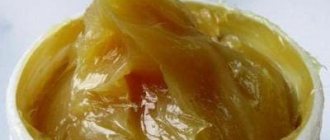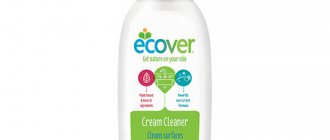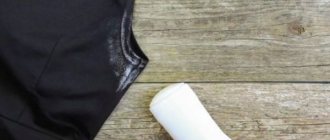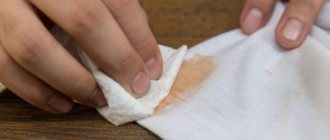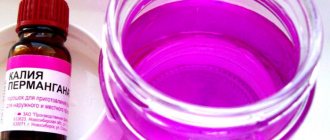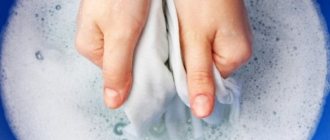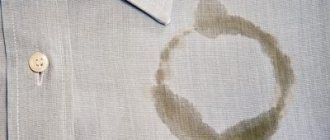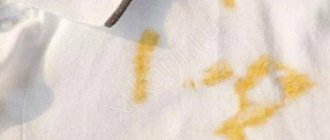It's easy to stain clothes with paint, but getting rid of the stain is much more difficult. To cope with it and not damage things, you need to act quickly.
To remove paint, you can use both improvised means and professional household chemicals. Regardless of the chosen cleaning method, existing rules cannot be neglected.
In this article we will tell you how to remove printer ink, stamp ink, and construction ink from white, black and colored clothes at home.
Leather
Clothes and bags made of leather can also be stained with stamp ink. Here you will need to use completely different means. Take glycerin and denatured alcohol mixed in equal parts and rub into the stain. After exposure to the mixture, the treated area will lighten. Leather paint will cope with this task.
Stamp ink, due to its durability, is also difficult to wash off the skin of your hands. Toothpaste can help by rubbing the stained area and rinsing it off.
Citric acid or natural cherry juice also works well to whiten ink. Any product containing alcohol is worth trying. Nail polish remover can remove stains. The most gentle way to remove stains on the skin of your hands is to use a rich cream or soap solution. If contaminants still remain, you will have to use products such as white spirit, gasoline or thinner. They will effectively clean your hands of paint stains.
White toothpaste will help remove paint from leather products
How can I wash different types of paint and varnish products?
Depending on the type of paint, the cleaning method will vary. All recommendations can be found in the table:
| Paint type | Remover |
| Acrylic | Salt, vinegar, ammonia (ammonia), acetone. |
| Oil and enamel | Gasoline, kerosene, white spirit, acetone, “butter + washing powder”. |
| Watercolor and gouache | Soap, washing powder, any stain remover. |
| Printer ink | Alcohol compounds, lemon juice or vinegar, laundry soap, |
| Alkyd | Laundry soap, acetone, turpentine, white spirit, kerosene, ammonia. |
| Water-based | Laundry detergents containing high levels of surfactants. Fresh stains are removed with alcohol compounds. |
| Stamp | Turpentine, ammonia, glycerin. |
| For hair | Any products containing alcohol. |
One hundred percent methods and methods for removing bench paint from clothes are presented in this article.
Light things
Light-colored fabric will be cleaned of stamp stains using acids. You can rub the stain with lemon juice, then plunge the contaminated area into boiling water for thirty seconds. But there is a more effective way. To do this you will need:
- oxalic acid –10 grams;
- citric acid – 10 grams;
- water – 100 milliliters.
Mix the components and apply the composition to the stained area. When the acids dissolve the stain, the fabric remains to be rinsed thoroughly.
Lemon, oxalic acid and water are mixed and applied to the stain
Paint stains on various types of fabric
It’s easiest with natural cotton - it can be washed in hot water and even boiled. White items are also easier to wash, even though the stains on them are the most noticeable. Don't be afraid of bleaches, in some cases even "Whiteness" will be appropriate.
Do not use bleaches on colors; look for stain removers labeled “color.”
Synthetics, modern sports materials, leather, suede require careful handling.
Paint on delicate fabrics
Do not rub the paint stain or scrape it with a knife - there is a high probability of tearing the thin fibers. The method of soaking and washing the paint should follow the recommendations on the label. If you hand wash at 30 degrees, then your only hope is solvent and powder.
Important tip: Apply the cleaner to the stain from the inside out. Avoid harsh solvents as much as possible.
Paint on jeans
Blue denim should not come into contact with bleaches. Colored stain removers, laundry soap, and gasoline work well on jeans.
Removing different types of paint
Before you start washing the paint, you need to distinguish the type of dye. Each variety has a special composition, which is why the methods for removing blots vary.
Water based paint
This type includes watercolor, gouache and water-based paint. Thanks to their composition, they are easily washed off, and their pigment is not as bright as that of acrylic and oil paint.
If the blot has not had time to be absorbed, then it is enough to rinse the clothes under the tap, then soak them in a basin and throw them in the washing machine.
You can use dishwashing detergent or a concentrated powder solution. Alcohol helps with old dried stains - moisten a sponge with it and clean off the dirt.
Oil based paint
Oil paint is difficult to remove, so you need to use household chemicals with a high concentration of surfactants.
First, the top layer of contamination is removed with a sharp object, but care must be taken not to tear the product. The stain is treated in a circular manner with cotton wool soaked in kerosene. You should move from the edges to the middle.
Next, the blot is soaped (ideally with laundry soap) and rinsed under the tap. After cleaning, the product should be washed in a machine or by hand.
In addition, you can use:
- Powder and butter. The ingredients are mixed and rubbed into the stain, and the item is washed in a couple of minutes.
- Vegetable oil. It is used as a solvent: applied to the blot and the residues are removed along with the paint.
- Soap and soda. A liter of water is poured into the pan, then 1 tbsp is added. l. soda and 200 g of soap shavings. The solution is boiled, then the item is lowered into the container for 10 minutes.
Advice. Since oil paint stains are difficult to remove, preventive measures should be taken. You need to drop a little shampoo into the bottle of paint - then the pigment will wash off from clothes much easier.
Acrylic
To remove acrylic paint you need to go through several steps:
- First you need to turn on cold water and place the dirt under the stream for a couple of minutes.
- Then the product is washed at 40°C for 1.5-2 hours.
- If the blot turns out to be dry, then prepare a thick slurry from washing powder and water. It is applied to the brush to make it easier to remove the stain.
- The item is washed again, but at the maximum temperature setting suitable for this type of fabric.
- For particularly difficult stains, use bleach, for example, Vanish. It is recommended to purchase a product without chlorine and other aggressive impurities.
Attention! You should choose the right household chemicals, since powders, gels and bleaches are divided according to the color of the fabric being processed, as well as the type of material.
You can look for acrylic remover in art stores. It is poured onto the dirt and the paint begins to soften. It is enough to remove the remains with a sponge and wash the damaged item.
Acrylic remover
Enamel
Before you start scrubbing paint with a solvent, you need to determine the type of fabric. It should not be used on delicate materials as there is a risk of damage to the fibers.
The main ingredient of enamel is varnish. If the fabric allows, the popular solvent White Spirit can help. You need to treat the dirt with a moistened cotton wool, and then put the item in the machine.
From delicate materials, the blot can be removed using turpentine or vegetable oil - you also need to saturate the sponge and wipe off the dye. In addition, industrial alcohol and ammonia, heated in a water bath, help. Finally, it is recommended to wash the item in salt water.
We recommend:
How to bleach synthetic whites at home
Important Tips
When removing paint from fabrics, you should adhere to the following recommendations:
- Carefully study the information on washing items.
- Do not wash dirty and clean items together.
- observe the stain remover dosage.
- When choosing a product, pay attention to the type of fabric and type of paint.
Do not rub the fabric too hard to avoid damaging its integrity.
Classification of stains by paint
The best way is the most appropriate in the current situation. That is, in order to remove any stain, you need to know the source of the contamination. There are several types of the most common paints:
- artistic (gouache, watercolor, tempera, acrylic);
- repair (alkyd, silicone, acrylic, oil);
- hair dyes (eyebrows, eyelashes);
- food (natural, synthetic).
Depending on the type of paint, degree of contamination, and age, stains can be easily removed using inexpensive and accessible products.
Rules for removing marks from white, black and colored clothes
When removing dye from white items, the following rules must be observed:
- White items should be soaked separately from colored items.
- Do not try to wipe a stain from a white item with a colored cloth or napkin.
- Items made from natural and synthetic fabrics can be soaked in stain removers and bleaches for a long time.
- You need to rinse the products in warm and then in cool water.
- For white items, you can use products that contain bleaches.
- When removing a stain, the napkin or cotton pad should be changed regularly.
When cleaning colored items, the following rules must be observed:
Black and colored items should be washed separately.- Do not use aggressive stain removers or products containing bleaches to remove paint.
- The maximum soaking time is 1 hour.
- Do not rub the stain too hard with a brush, so as not to provoke the removal of the tissue’s own pigment.
- It is not recommended to wash colored items in water above 40-60 degrees.
Each product has a label on which the rules for washing clothes are indicated. It is located on the inside of the product. This information is required to be read.
Basic rules for removing ink
Ink in fountain pens, seals or stamps is made on a water-glycerin base or a dispersed medium with a solvent and alcohol. Contains a colored pigment that is insoluble in water. Ink tends to penetrate firmly and quickly into various surfaces (it has strong adhesion to materials), which is why it is so difficult to get rid of. Conventional detergents (soap, powder, washing gel) cannot remove them - it is necessary to use substances that dissolve the base and pigment.
Most fountain pen inks are water-soluble, so contact with water can cause the ink to spread across the surface. Therefore, it is not recommended to wet clothes stained with ink.
Rules to follow:
- Sprinkle the ink stain with starch, crushed chalk or talcum powder. The powder will not only absorb part of the pigment, but will also prevent it from spreading.
- Before washing, be sure to remove any dirt, otherwise the ink will spread across the surface of the clothing.
- It is advisable to remove spilled ink from clothing immediately. Old traces are much more difficult to remove.
- Clean the contaminated area from the edges to the center. This will help avoid divorces. To prevent them, you can also sprinkle talc or starch around the edges of the blots.
- When removing an ink blot, place a napkin or rag folded several times under the area of fabric being treated. This rule must be followed when removing stains from trousers or sleeves of clothing, otherwise an ink print will appear on the other side.
- First test the cleaning product on an inconspicuous area of clothing. If the color of the fabric or its structure has not changed, you can use it to clean clothes.
- When applying cleaning products that dissolve the dye in ballpoint pens, there is no need to wait - the stain must be removed immediately, without allowing the solvent to dry.
- When removing contamination with aggressive agents, you should use gloves and a respirator. Protect children and allergy sufferers from inhaling these substances. It is advisable to carry out the treatment with an open window or in the fresh air.
Compliance with these rules will protect clothes from damage during processing and maintain health.
